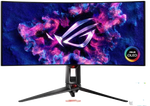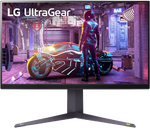A comparison of specs, key information, reviews, and best pricing from top retailers
Last updated -- hours ago | Report incorrect information
What we think

The PerfectRec monitor team Learn more
Updated April 11, 2024·
If you're a competitive gamer looking for the smoothest experience with deep blacks and high contrast, the Asus PG34WCDM with its OLED panel is a strong option, despite the high cost. However, if you're focused on productivity or print photo editing, you'll find better value with the LG 32GQ850 due to its higher color accuracy in some color spaces, although it doesn't offer the same level of contrast or motion handling as the Asus. The LG's lower price also makes it more accessible if budget is a concern, but for HDR gaming and media consumption, the Asus outshines the LG. Give Feedback
this description is based on the product variant with some specs and product variant with some specs. At the time of writing, the variant with some specs cost some dollars and the variant with some specs cost some dollars.
Advantages of the Asus PG34WCDM (W-OLED)
- Best in class for casual gaming
- Good for media consumption
- Good image clarity
- Best in class contrast
- Best in class response time
Advantages of the LG 32GQ850 (IPS)
- The LG 32GQ850 (IPS) has no clear advantages over the Asus PG34WCDM (W-OLED).
Key differences
Casual Gaming
9.5


5.8
3440 x 1440
RESOLUTION
2560 x 1440
240Hz
REFRESH RATE
260Hz
Inf:1
NATIVE CONTRAST
1000:1
238 nits
SDR PEAK BRIGHTNESS
150 nits
716 nits
HDR PEAK BRIGHTNESS
600 nits
96.6 %
DCI-P3 COLOR GAMUT
98.0 %
Matte
COATING
Matte
The Asus PG34WCDM (W-OLED) is best in class for casual gaming, while the LG 32GQ850 (IPS) is poor.
Productivity
5.7


5.0
3440 x 1440
RESOLUTION
2560 x 1440
109 PPI
PIXELS PER INCH
93 PPI
Yes
ADJUSTABLE STAND
Yes
Matte
COATING
Matte
The Asus PG34WCDM (W-OLED) and LG 32GQ850 (IPS) are both poor for productivity, though the Asus PG34WCDM (W-OLED) is somewhat better.
Media Consumption
7.5


5.3
3440 x 1440
RESOLUTION
2560 x 1440
Inf:1
NATIVE CONTRAST
1000:1
238 nits
SDR PEAK BRIGHTNESS
150 nits
716 nits
HDR PEAK BRIGHTNESS
600 nits
Matte
COATING
Matte
The Asus PG34WCDM (W-OLED) is good for media consumption, while the LG 32GQ850 (IPS) is poor.
Cost
$1,300


$718
$0
$500
$1,000
$1,500
$2,000
The Asus PG34WCDM (W-OLED) has a price of $1,300 and the LG 32GQ850 (IPS) costs $718.
HDR Gaming and Media Consumption
Yes


No
The Asus PG34WCDM (W-OLED) is suitable for HDR gaming and media consumption while the LG 32GQ850 (IPS) is not suitable for HDR gaming and media consumption.
Print Photo Editing
No


Yes
The Asus PG34WCDM (W-OLED) is not suitable for print photo editing while the LG 32GQ850 (IPS) is suitable for print photo editing.
Key similarities
Competitive Gaming
5.6


5.2
240Hz
REFRESH RATE
260Hz
1.1 ms
TOTAL RESPONSE TIME
8.0 ms
20 - 240 Hz
VARIABLE REFRESH RATE
48 - 260 Hz
Yes
STROBING / BFI
No
238 nits
SDR PEAK BRIGHTNESS
150 nits
The Asus PG34WCDM (W-OLED) and LG 32GQ850 (IPS) are both poor for competitive gaming.
Digital Photo Editing
Yes


Yes
Both the Asus PG34WCDM (W-OLED) and LG 32GQ850 (IPS) are suitable for digital photo editing.
HDR Video Editing and Color Grading
No


No
Both the Asus PG34WCDM (W-OLED) and LG 32GQ850 (IPS) are not suitable for HDR video editing and color grading.
Give feedback
We’re constantly working to improve.
How the Asus PG34WCDM (W-OLED) and the LG 32GQ850 (IPS) compare to other monitors
Spec Comparison
| Asus PG34WCDM (W-OLED) | LG 32GQ850 (IPS) |
GENERAL | |||
|---|---|---|---|
| Price | |||
$1,300 | $718 | ||
Screen Size | |||
Screen Size | 34" | 32" | |
Resolution | |||
Resolution | 3440 x 1440 | 2560 x 1440 | |
Screen Type | |||
Screen Type | OLED | LED | |
Screen Sub-type | |||
Screen Sub-type | W-OLED | IPS | |
Local Dimming Zones | |||
Local Dimming Zones | N/A | 16 | |
COLOR, CONTRAST & BRIGHTNESS | |||
|---|---|---|---|
Native Contrast | |||
Native Contrast | Inf:1 | 1000:1 | |
SDR Peak Brightness | |||
SDR Peak Brightness | 238 nits | 150 nits | |
HDR Peak Brightness | |||
HDR Peak Brightness | 716 nits | 600 nits | |
Suitable for HDR Gaming and Media Consumption | |||
Suitable for HDR Gaming and Media Consumption | Yes | No | |
sRGB Color Gamut | |||
sRGB Color Gamut | 100 % | 135 % | |
MOTION CHARACTERISTICS | |||
|---|---|---|---|
Total Response Time | |||
Total Response Time | 1.1 ms | 8 ms | |
Variable Refresh Rate | |||
Variable Refresh Rate | 20 - 240 Hz | 48 - 260 Hz | |
Strobing / BFI | |||
Strobing / BFI | Yes | No | |
Persistence Blur Score | |||
Persistence Blur Score | 8/10 | 8.3/10 | |
Ghosting Score | |||
Ghosting Score | 9.6/10 | 7.6/10 | |
TEXT & IMAGE CLARITY | |||
|---|---|---|---|
Pixels Per Inch | |||
Pixels Per Inch | 109 PPI | 93 PPI | |
Coating | |||
Coating | Matte | Matte | |
Text Clarity Score | |||
Text Clarity Score | 6.6/10 | 6.3/10 | |
Image Clarity Score | |||
Image Clarity Score | 7/10 | 6.3/10 | |
PORTS & CONNECTIVITY | |||
|---|---|---|---|
HDMI 1.4 Ports | |||
HDMI 1.4 Ports | 0 | 0 | |
HDMI 2.0 Ports | |||
HDMI 2.0 Ports | 0 | 0 | |
HDMI 2.1 Ports | |||
HDMI 2.1 Ports | 2 | 1 | |
Micro HDMI Ports | |||
Micro HDMI Ports | 0 | 0 | |
DisplayPort 1.2 Ports | |||
DisplayPort 1.2 Ports | 0 | 0 | |
Give feedback
We're constantly perfecting our model
More comparisons for you
Compare Asus PG34WCDM (W-OLED) vs. Asus PG32UCDM (QD-OLED)
VS
Compare Asus PG34WCDM (W-OLED) vs. LG 34GS95QE (W-OLED)
VS
Compare Asus PG34WCDM (W-OLED) vs. AOC AG456UCZD (W-OLED)
VS
Compare LG 32GQ850 (IPS) vs. Innocn 27M2V (IPS MiniLED)
VS
Compare LG 32GQ850 (IPS) vs. Acer X34V (QD-OLED)
VS
Compare LG 32GQ850 (IPS) vs. AOC AG276QZD (W-OLED)
VS
FAQs
Why trust us
This information was produced and vetted by the PerfectRec monitors team. We are a product research and recommendation organization that meticulously reviews and evaluates the latest monitor information and makes it digestible for you.
By the numbers
210
Monitors evaluated
10,500
Monitors stats compiled
15
Proprietary Monitors ratings developed
117,500
Recommendations made
17,625
Consumer hours saved
About the monitor team
Joe Golden, Ph.D
CEO and Monitors Editor
Joe is an entrepreneur and lifelong electronics enthusiast with a Ph.D in Economics from the University of Michigan.
Jason Lew
Staff Expert & Software Engineer
Jason is a staff expert and software engineer that has been making laptop recommendations for 7 years and moderates one of the largest laptop subreddits.
Chandradeep Chowdhury
Staff Expert & Software Engineer
Chandradeep is a staff expert and software engineer and expert in televisions and monitors. He’s been making monitor recommendations for ten years.







